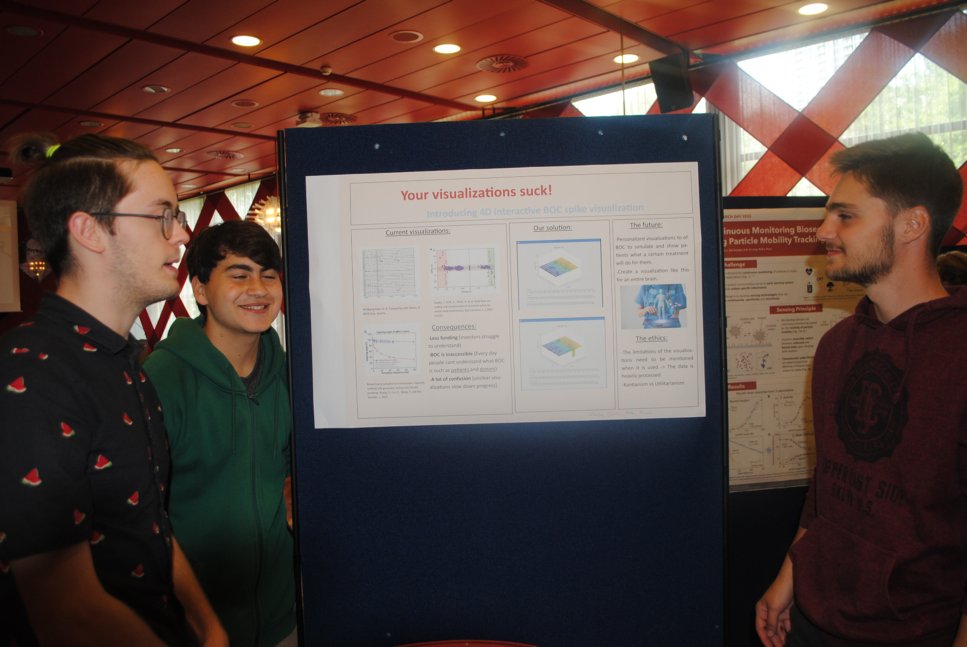Insights from the Data and Health-Mobility-Energy Course on USE
Interview with Adam Watkins, Teacher of Mathematics and Computer Science, about the Bachelor Q4 course Data and Health-Mobility-Energy (4CBL20) with 60 students.
The course covers the basics of USE. USE stands for User (U) values and preferences, such as privacy or ease of use; Societal (S) priorities, such as sustainability and safety; and Enterprise (E) concerns, such as financial viability and data security. Students learn how to take the USE context into account in their technical innovations.
Its assessment features an interesting combination of group and individual submissions. This way, students learn to perform as a group while also demonstrating their individual achievements. It fosters student engagement and prevents so-called free riding.
Q: Can you briefly describe the format of the assessment?
Adam: “Among other outputs, we had students create reports in groups and give a poster presentation. In addition to the group report, students also had to individually report on the details of the project. On the ethics side of the course, they were to have short oral examination. The students received an overview of questions beforehand, but they did not know which question they had to answer individually until just before the oral exam..
Students who really put effort into the course and the group showed more detailed information in their individual reports. It also supports students who are mostly quieter in discussions but contribute significantly to the group results."
Q: And to identify so-called free riders right?
Adam: "You know, I don't like the way we talk about student free riding during courses. It assumes that students are deliberately trying to cut corners, which is almost never the case. The number of students who purposefully perform poorly is probably much smaller than we often think.
During this course, we identify poorly performing students quite easily during the coaching sessions. It mostly turns out that it is not unwillingness, but inability or not knowing how to engage.
For example, one student who did not participate in group work and kept withdrawing appeared to be unwilling to take part in group activities; but were actually overstimulated. This happened because they were working with all the groups at the same time in one room. When we moved the group to a quieter room, they were able to participate much more actively and easily.
Another student did not take initiative or come up with ideas, which caused friction in the group. When she discussed this with her coach, they discovered that it was because her cultural background taught her to wait and be quiet. After this discussion, they made new agreements, and their collaboration approved.
So instead of talking about how to catch free riders, I think it is better to talk about how to design methods that stimulate student engagement.
Q: Were the expectations from the students clear?
Adam: “Good point, because sometimes this is also lacking. Teachers then notice resignation or passivity in students. They may not realize that this occurs because the we have not clearly communicated the expectations or engaging behavior in the Intended Learning Outcomes (ILOs).”
Q: Could you provide an example of how to include student engagement in the ILOs?
Adam: "Yes of course, we had the ILO: “Demonstrate self-reflective awareness of the technical and USE constraints on data analysis problems.” And we also put reflection as an extra step in the process and a separate deliverable for the assessment.
We asked students to submit a weekly reflection report in which they answered three questions: 1. What did you learn? 2. How did you learn it? 3. How did you integrate it into the group project?
From my experience, the last question, in particular, increases engagement. Students can do the first two questions on their own, but for the last question they really had to engage with the group learning and their outcome.
Q: What assessment format did you leave out of the plan?
Adam: “We cancelled the oral exams for the data analysis element of the final submission. Our intention for next year is to do this for another course. I think that way we can assess the output in more depth than just with reports.
This decision was made because the USE learning line focused on ethics, and it was decided that the written submission on the data analysis part was sufficient.
During the course, students were invited to give poster presentations at a conference. While this wasn't initially planned, the opportunity arose in week 4 and was too valuable to miss. Although not officially part of the assignments we took it into account when grading. It also fit neatly into one of the submission requirements. As the students invested time in the poster presentations, us teachers used it as an opportunity to do a kind of oral assessment - more a chat and stream of compliments. Another reason we sholdn’t do so many oral interviews.

Q: What lessons learned would you like to pass on to your colleagues.
Adam: “During the first two or three weeks, students feel lost.. This happens in both undergraduate and postgraduate courses. This is where you, as a teacher or tutor, step in to guide them. These first weeks are the most important.
However, you can avoid a lot of confusion by creating very clear rubrics. It can go too far though with extremely elaborate rubrics that students may have trouble interpreting! So test your rubrics beforehand so that you can remove any ambiguity.
I've also seen teachers avoid using rubrics as much as possible to shift the focus from grading to improving competence. In my experience, it is very difficult to reduce the grading focus in students, even in CBL subjects. At the end of the day, we still have to give a grade at the end of a course. And so grading will remain the a focal point for students.
And as mentioned earlier, being aware of the cultural and neurodivergence in students reduces the chances of us taking a pessimistic view of student engagement ”
More information
- For more details about the course go the case description of Data and Health - Mobility- Energy (4CBL20 ). Here you will find a short description of the set-up and the used studyguides, assessment guide and grading guide. Feel free to contact Adam in case of questions and reuse their materials.
- Publication about research on the reflection method using the 3 questions. Results: “We describe (1) that the method provided in-depth reflections of the students but is not scalable, (2) a distribution of different ethics goals, and (3) strengths and gaps (epistemology, pedagogical) of the two models in the use of reflective evaluation.”
- Publication about research on the course evaluation consisting of a survey and two open-ended questions. Results: “Results indicated that students appreciated the real-life aspect of the challenge, and a client’s involvement enhanced their engagement to the challenge and made their learning relevant. On the other hand, students seemed to find the course structure quite complicated, with many meetings during the week, several communication platforms, and the distribution of individual and group work for the final assignment.”
- Publication of the Research Full Paper on how students engage with societal aspects. Results: “The study’s preliminary findings show that the CBL format fostered a broad understanding of professional responsibility in the course’s deliverables, which included micro and macroethical understandings.”
